South Carolina is well-known for its beaches and historic towns. That said, the state also boasts a colorful assortment of wildlife. After all, it shares its nickname, The Palmetto State, with the name for its state tree. You can find many kinds of plants and animals in South Carolina, from alligators to wild boars. The state is also home to a wide variety of spiders. From orb weavers to wolf spiders, you can find all sorts of spiders in The Palmetto State. To celebrate that diversity, here is a list of 10 spiders in South Carolina.

#10. Mabel Orchard Orb Weaver
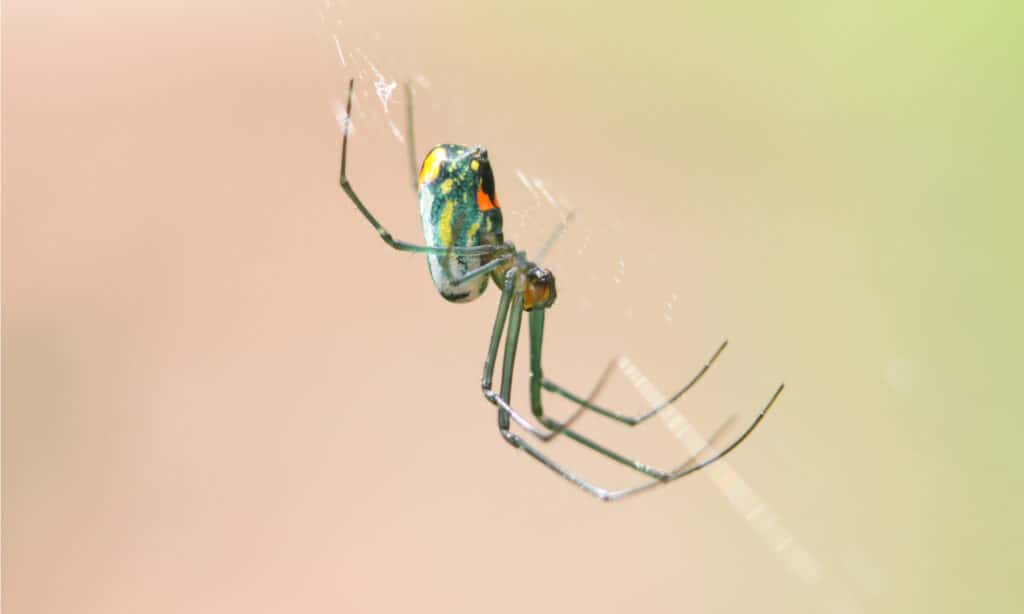
The Mabel orchard orb weaver was named by Charles Darwin.
©MJANaturePics/Shutterstock.com
The Mabel orchard orb weaver, Leucauge argyrobapta, is a member of the long-jawed orb weaver family Tetragnathidae. It ranges from Canada in the north to Brazil in the south.
Adult females measure 5.5 to 7.5 millimeters long and males measure 3.5 to 4 millimeters long. They easily rank as one of the most colorful orb weaver spiders in South Carolina. Their legs look green with black bands, while the cephalothorax appears primarily tan. In Greek, argyrobapta means “dipped in silver,” a reference to the silvery abdomen that features orangish-red markings and yellow, black, and green stripes.
The famous naturalist, Charles Darwin, named the Mabel orchard orb weaver during his storied voyage on the H.M.S. Beagle. It makes a horizontally-oriented web that it uses to catch insects. When feeding, it pumps digestive enzymes into its prey to break down the body.
#9. Brown Widow

The brown widow spider has an hourglass pattern on its abdomen.
©Decha Thapanya/Shutterstock.com
Latrodectus geometricus is more commonly known as the brown widow. It belongs to the cobweb spider family Theridiidae and lives in subtropical regions throughout the world.
Female brown widows measure 12 to 16 millimeters long, while males measure between 6 and 8 millimeters long. Unlike their more famous cousin, the black widow spider, brown widows appear primarily brown and tan with black markings. That said, they still feature a distinctive hourglass-shaped marking on the abdomen like other widows.
Despite their name, brown widows are not ranked as one of the more dangerous spiders in South Carolina. This is because they do not deliver as much venom per bite as black widows. That said, they are still poisonous and possess neurotoxic venom. Typically their bite causes mild symptoms including pain, redness, and swelling localized to the bite area.
#8. Twin-Flagged Jumping Spider
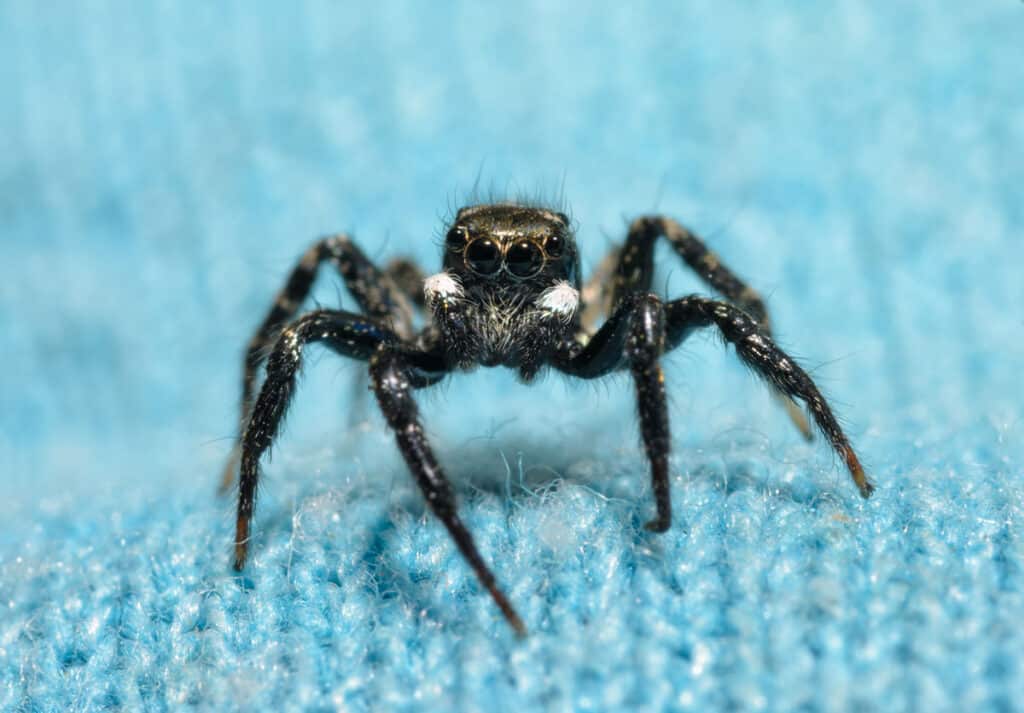
The twin-flagged jumping spider gets its name from the 2 pennant-shaped markings on its cephalothorax.
©Sari ONeal/Shutterstock.com
The twin-flagged jumping spider, Anasaitis canosa, belongs to the jumping spider family Salticidae. You can find these tiny spiders in South Carolina as well as throughout most of the southeastern United States.
Adult twin-flagged jumping spiders measure 5 to 6 millimeters long, with males measuring slightly smaller than females. They feature two flag-shaped markings on the bottom of the cephalothorax, hence their name. Meanwhile, the carapace looks primarily black except for two white dots. Like other spiders in the genus Anasaitis, they sport shiny scales ranging in color from white to green to pink on the abdomen cephalothorax and abdomen.
Twin-flagged jumping spiders use their excellent eyesight and agility to capture prey. They tend to face their prey head-on and then leap onto their target to land a killing blow with their chelicerae. Due to their small size, their bite is not medically significant.
#7. Southern House Spider
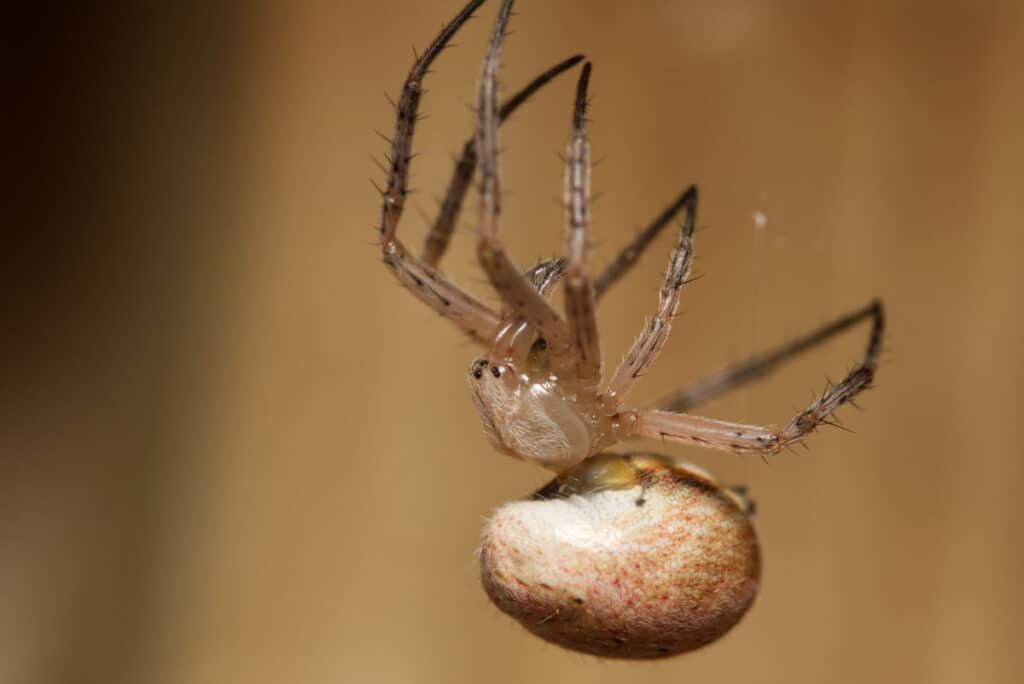
Southern house spiders often get mistaken for brown recluses due to their similar markings.
©Kala Stuwe/Shutterstock.com
Kukulcania hibernalis, also known as the southern house spider, is one of the most common spiders in South Carolina. It ranges throughout most of the southern United States, South America, and the Caribbean.
Adult southern house spiders measure can reach up to 5 centimeters long with their legs extended. Unlike many other spider species, males and females measure roughly the same size. That said, males tend to possess longer legs, while females have larger bodies. They usually appear primarily brown, although males tend to look lighter than females.
You can often find southern house spiders in or near human dwellings, hence their name. They make radial-style webs made of non-sticky threads to trap their prey. They rarely act aggressively toward humans, and their bite poses little to no threat to humans.
#6. Six-Spotted Fishing Spider
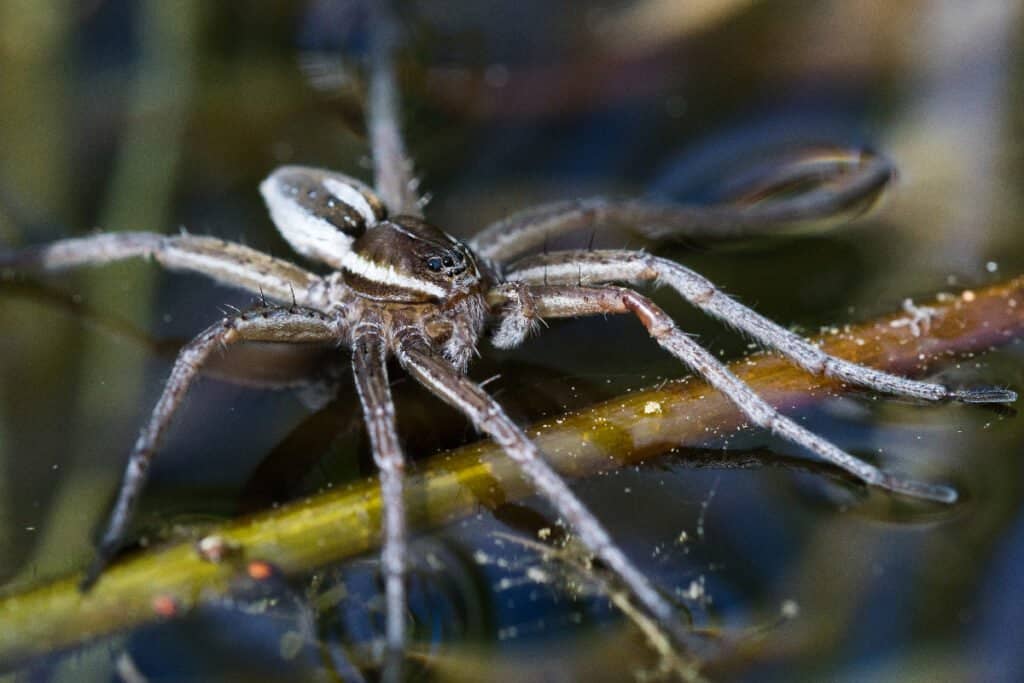
The six-spotted fishing spider can catch fish more than five times its own size.
©Jukka Jantunen/Shutterstock.com
The six-spotted fishing spider, Dolomedes triton, is a member of the nursery web spider family Pisauridae. It ranges throughout much of North America, particularly near wetlands.
Female six-spotted fishing spiders measure from 15 to 20 millimeters long, while males measure 9 to 13 millimeters long. They look primarily grey or brown except for a whitish-cream stripe along each side. The top of the abdomen sports a number of light spots. Meanwhile, they get their name from the six dark spots situated on the bottom of the abdomen.
Six-spotted fishing spiders use one of the more unusual methods of catching prey compared to other spiders in South Carolina. Instead of using webs, they hunt by using their legs as fishing lures to snag insects or small fish from the water. They can also dive into the water or run across its surface to capture prey.
#5. Labyrinth Orb Weaver
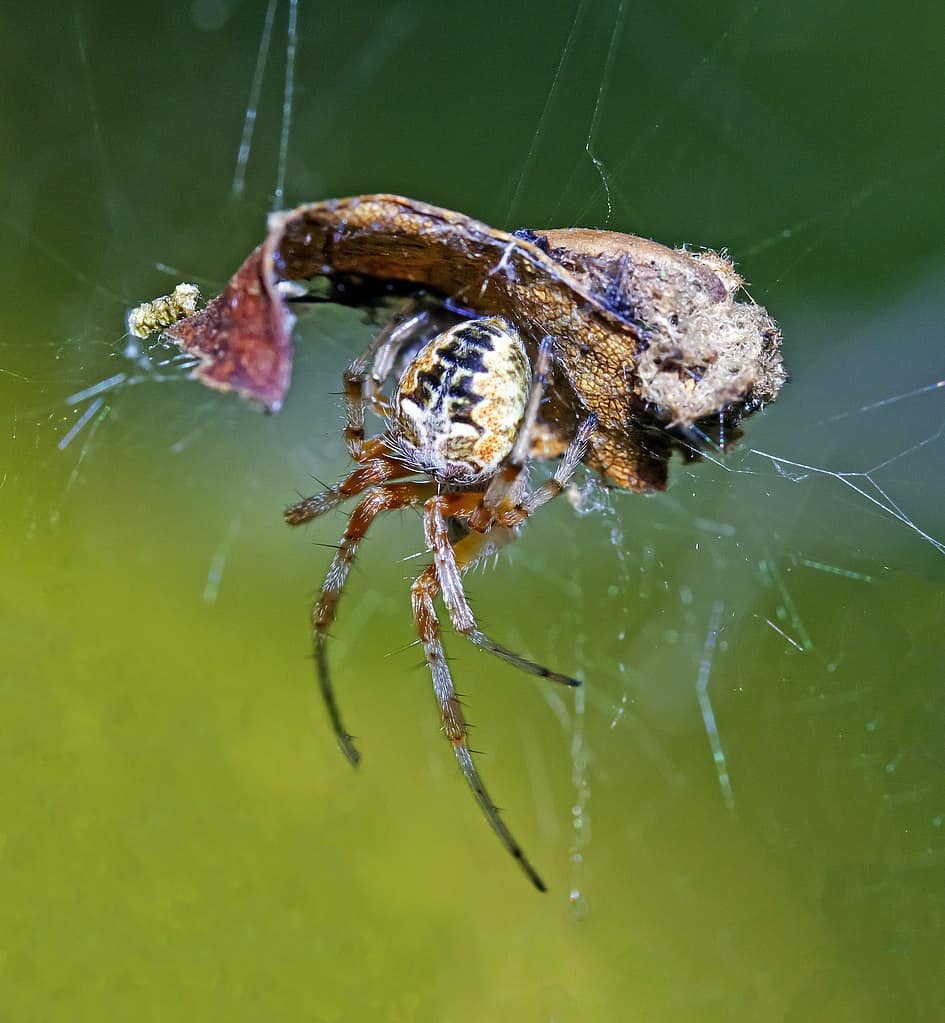
The labyrinth orb weaver builds a web consisting of both an incomplete orb and a tangled cobweb.
©WanderingMogwai / CC BY-SA 4.0, via Wikimedia Commons – License
Metepeira labyrinthea, or the labyrinth orb weaver, belongs to the orb-weaver family Araneidae. You can find these spiders in South Carolina and throughout the United States south to Argentina.
Adult females measure barely over 5 millimeters long while males measure only slightly smaller. They possess thin legs and round, bulbous abdomens like other orb weavers. The carapace looks either grey or brown, while the abdomen appears dark with white markings. Additionally, they feature light hairs around the eyes and a white median line across the sternum.
Labyrinth orb weavers weave highly unusual webs compared to other members of their family. They spin an incomplete orb web consisting of both an orb web designed to catch prey and an irregular web behind that serves as a retreat for the spider. Thanks to their small size, their bite is not medically significant.
#4. Green Lynx Spider
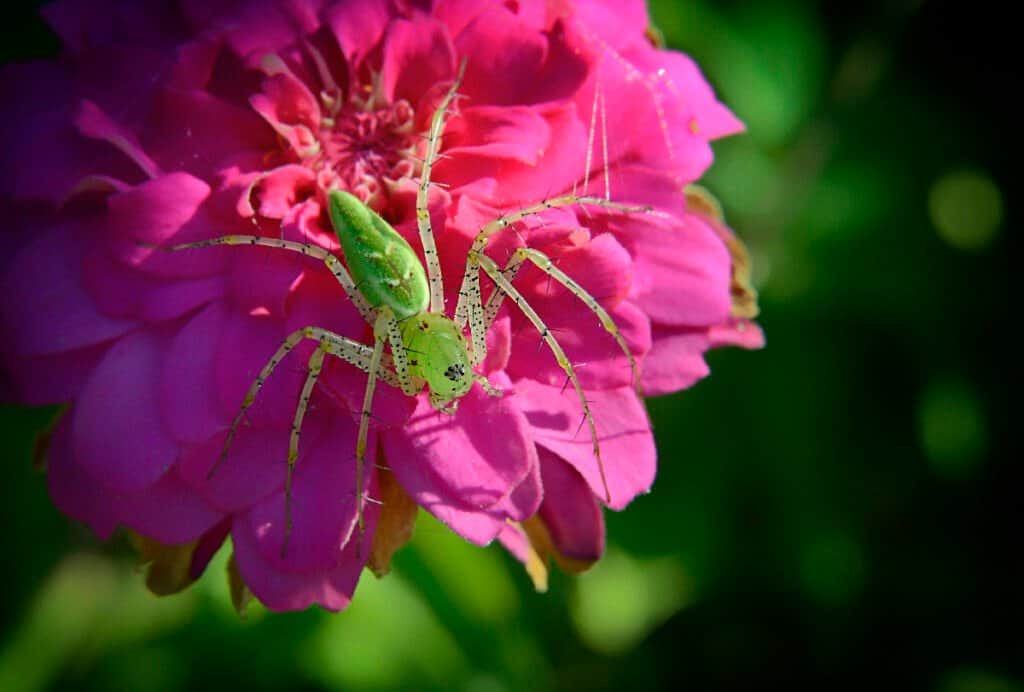
The green lynx spider is the largest species of lynx spider in North America.
©iStock.com/Lois_McCleary
The green lynx spider, Peucetia viridans, belongs to the lynx spider family Oxyopidae. It is the largest of the lynx spiders in South Carolina and throughout North America.
Female green lynx spiders measure 12 to 22 millimeters long while males measure only slightly smaller. They get their name from their distinctive green color. While they appear predominantly light green, they feature red markings on top of the abdomen. Additionally, the legs can sometimes appear more yellow than green.
Green lynx spiders do not use webs to capture prey. Instead, they actively wander in search of food and prey on numerous insects that feed on commercial crops. For this reason, many people consider them beneficial. Furthermore, they rarely act aggressively towards humans. Typically their bite causes little more than some mild pain, swelling, or redness.
#3. Spiny-Backed Orb Weaver

The spiny-backed orb weaver is also called the star spider due to its spiky appearance.
©iStock.com/Weber
The spiny-back orb weaver, Gasteracantha cancriformis, is the second member of the family Araneidae to make our list of spiders in South Carolina. It is widely distributed throughout much of North and South America as well as some parts of Central Asia.
Adult females measure between 5 and 9 millimeters long, while males typically measure 2-3 millimeters long. Females sport six long red or black spines on the abdomen, which is where they get their name. Meanwhile, the rest of the upper abdomen usually appears white with black markings. That said, other color variations exist. On the other hand, males feature stubby projections instead of spikes on a grey abdomen with white spots.
Spiny-backed orb weavers make webs that they use to trap their prey. They typically construct their webs in lightly wooded areas with a warm, humid climate. Their bite poses little threat to humans.
#2. Carolina Wolf Spider
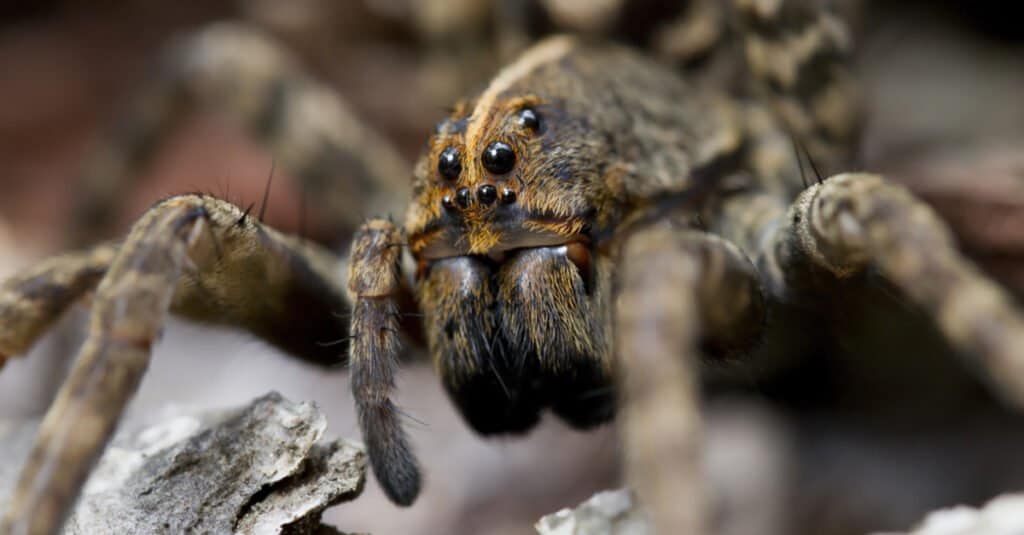
The forest wolf spider can reach nearly 50 millimeters long with its legs extended.
©Will E. Davis/Shutterstock.com
The Carolina wolf spider, Hogna carolinensis, belongs to the wolf spider family Lycosidae. It’s easily one of the most well-known spiders in South Carolina, which is where it gets its name. While named after the state, you can find it throughout much of North America.
Adult females measure between 22 and 35 millimeters long, and males measure 18 to 20 millimeters long. That said, they can measure up to 50 millimeters with their legs extended, making them the largest wolf spiders in North America. They look primarily light brown but feature numerous dark markings, while the males have orange sides.
Carolina wolf spiders do not use webs to trap prey. They usually ambush prey that wanders past their burrows but can also actively chase down their food. Their venom possesses the unique quality of simultaneously paralyzing and disinfecting their prey. Despite their large size, their bite is not medically significant.
#1. Pantropical Jumping Spider
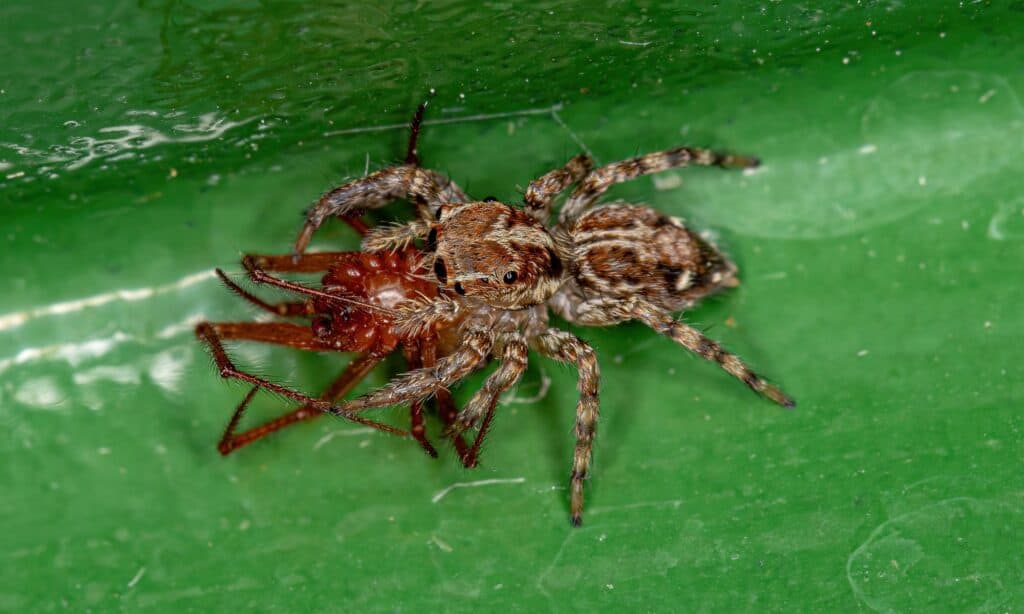
The pantropical jumping spider can take down prey twice its size.
©Vinicius R. Souza/Shutterstock.com
Plexippus paykulli is more commonly known in the United States as the pantropical jumping spider. It ranges mostly throughout tropical regions of Asia and Africa, hence its name. That said, you can now find these spiders in South Carolina and scattered around the world.
Adult females range from 9 to 12 millimeters long while males measure 9 to 11 millimeters. Males appear mostly black except for three stripes that run down the length of the body, one in the middle and one on each side. Meanwhile, females look primarily brownish-grey with a darker cephalothorax. The abdomen features a tan stripe down the middle that splits into two chevrons near the rear.
Pantropical jumping spiders typically live in or near buildings with plenty of light. They can take down prey twice their size, including flying insects. Their bite is not medically significant.
Summary of 10 Spiders in South Carolina
Here’s a recap of 10 spiders present in South Carolina that we took a look at.
| Number | Spider | Scientific Name | Length |
|---|---|---|---|
| 1 | Pantropical Jumping Spider | Plexippus paykulli | Females: 9-12 mm; males: 9-11 mm |
| 2 | Carolina Wolf Spider | Hogna carolinensis | Females: 22-35 mm; males: 18-20 mm. Can measure up to 50 mm with legs extended. |
| 3 | Spiny-Backed Orb Weaver | Gasteracantha cancriformis | Females: 5-9 mm; males: 2-3 mm |
| 4 | Green Lynx Spider | Peucetia viridans | Females: 12-22 mm; males are slightly smaller |
| 5 | Labyrinth Orb Weaver | Metepeira labyrinthea | Females: 5 mm; males are slightly smaller |
| 6 | Six-Spotted Fishing Spider | Dolomedes triton | Females: 15-20 mm; males: 9-13 mm |
| 7 | Southern House Spider | Kukulcania hibernalis | 50 mm with their legs extended |
| 8 | Twin-Flagged Jumping Spider | Anasaitis canosa | 5-6 mm; males are slightly smaller |
| 9 | Brown Widow | Latrodectus geometricus | Females: 12-16 mm; males: 6-8 mm |
| 10 | Mabel Orchard Orb Weaver | Leucauge argyrobapta | Females: 5.5-7.5 mm; males: 3.5-4 mm |
The photo featured at the top of this post is © Shelly Jefferson Morton/Shutterstock.com
Thank you for reading! Have some feedback for us? Contact the AZ Animals editorial team.






